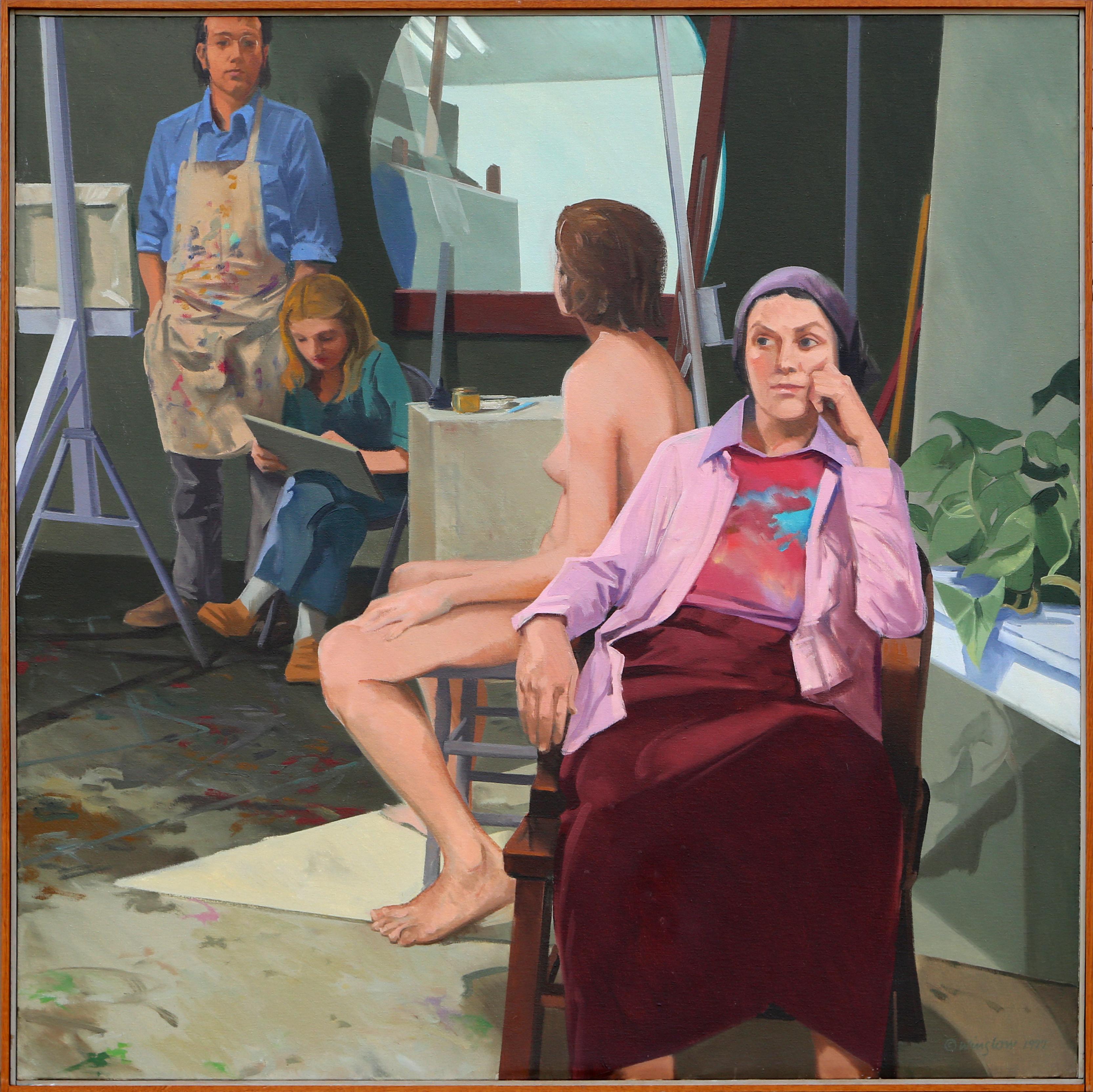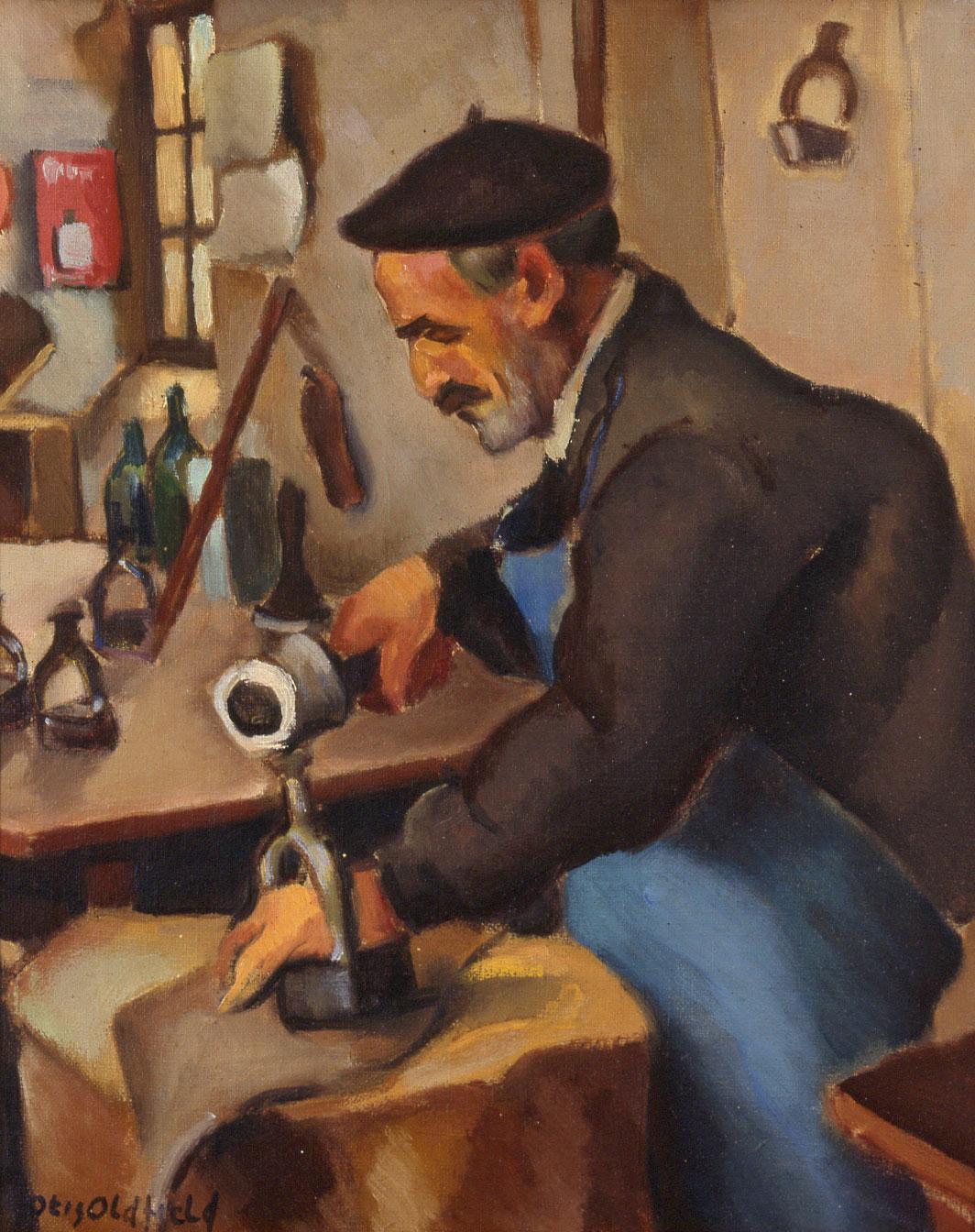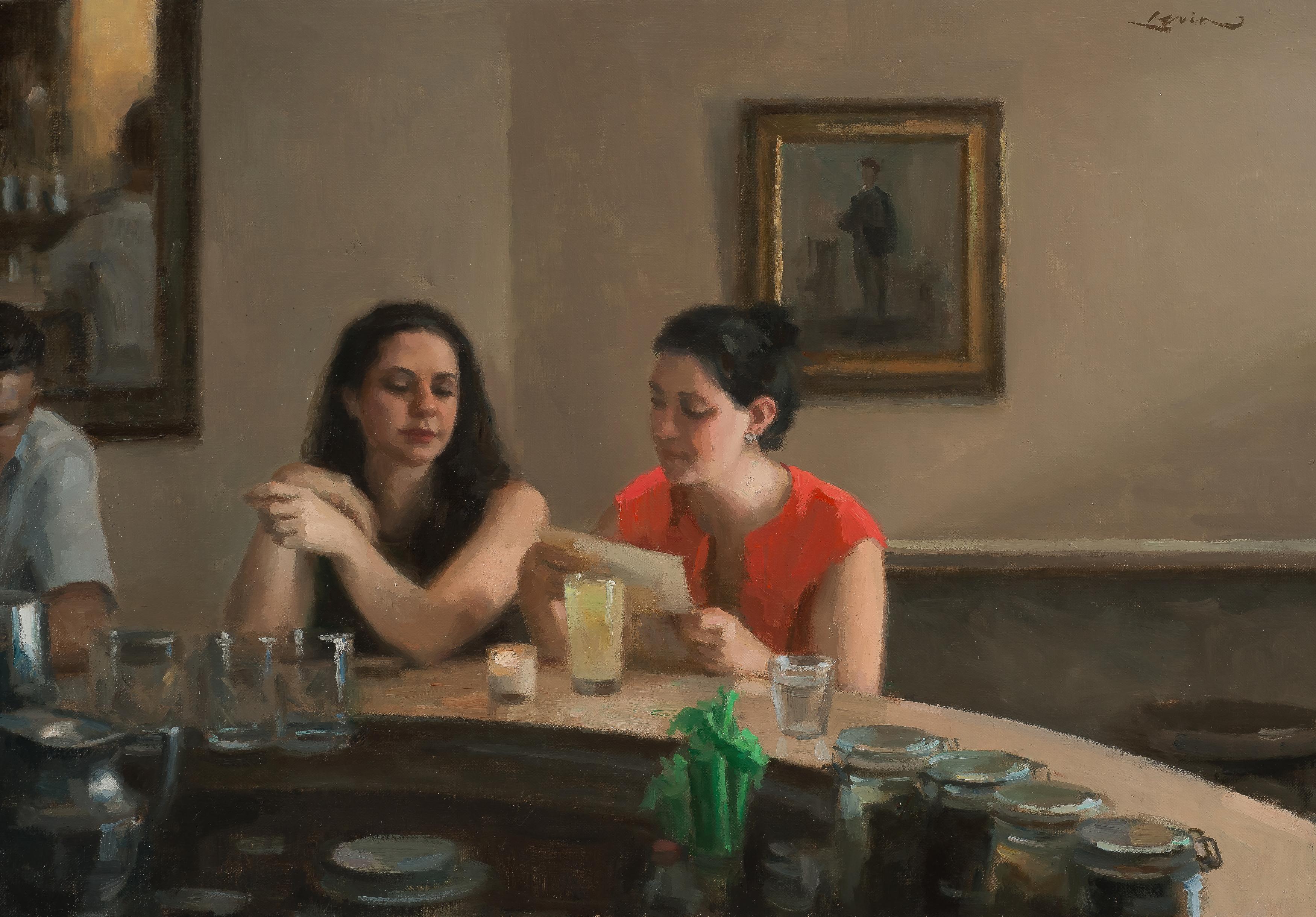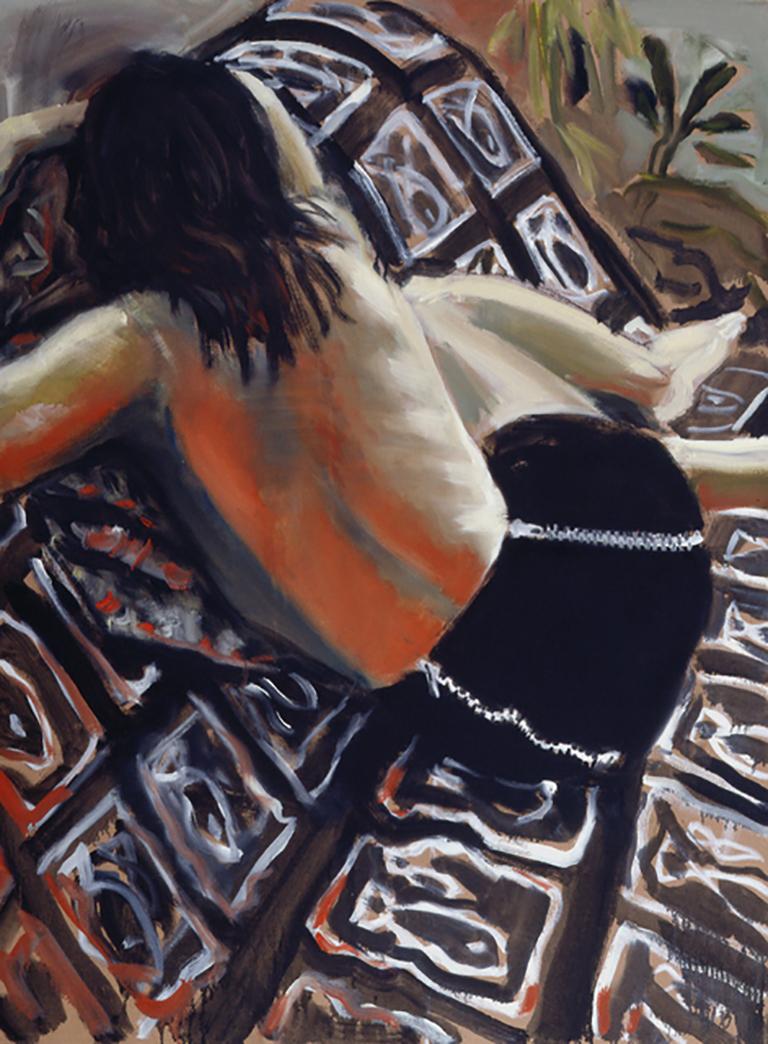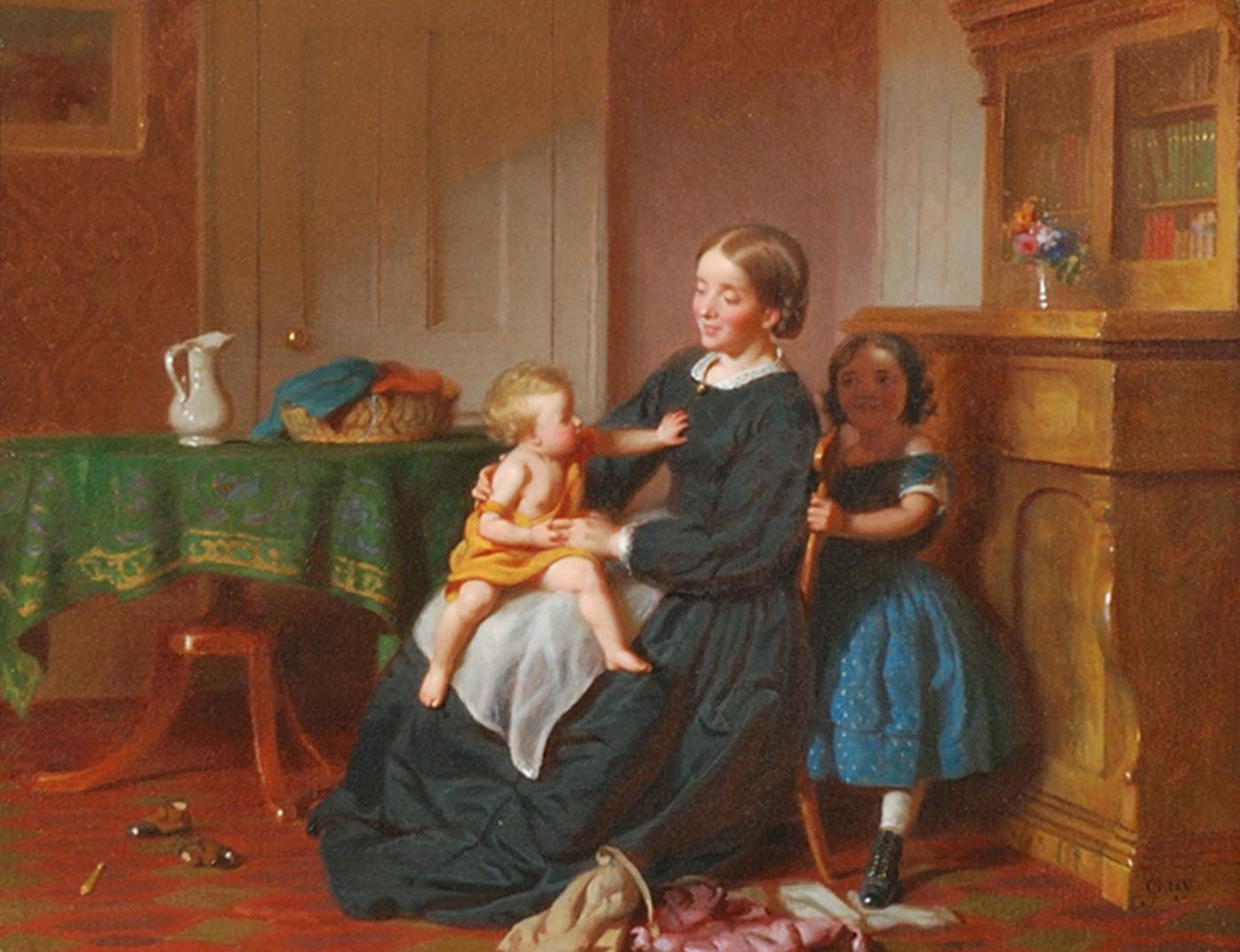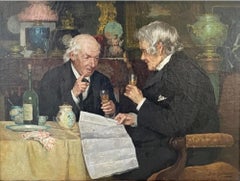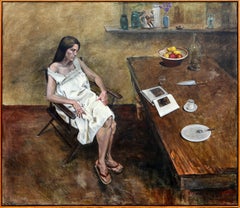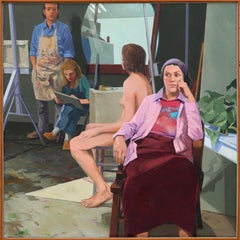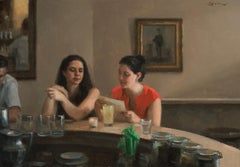Items Similar to "An Actor" George Luks, Ashcan Portrait, Interior Scene of Seated Actor
Want more images or videos?
Request additional images or videos from the seller
1 of 11
George Luks"An Actor" George Luks, Ashcan Portrait, Interior Scene of Seated ActorEarly 20th Century
Early 20th Century
About the Item
George Luks
An Actor
Signed lower left
Oil on canvas
18 x 24 inches
Provenance
Coe Kerr Gallery, New York, 1985
Manoogian Collection, Michigan
Artist George Luks was one of a group of U.S. painters popularly known as the Ashcan School because of their realistic treatment of urban scenes. His paintings of poorer classes, street scenes, portraits, and his interpretations of childhood show a free, spontaneous technique.
George Benjamin Luks was born on Aug. 13, 1867, in Williamsport, in a coal-mining region of north-central Pennsylvania. He studied first at the Pennsylvania Academy of the Fine Arts in Philadelphia and later in Germany, London, and Paris. Returning to the United States in 1894, he became an illustrator for the Philadelphia Press. During that period he met painter and teacher Robert Henri and newspaper illustrators John French Sloan and William J. Glackens. Luks went to Cuba in 1895 as a correspondent artist for the Philadelphia Bulletin during the Cuban struggle for independence from Spain. After returning to the United States, he worked as a cartoonist, drawing the popular strip “Hogan’s Alley” for the New York World.
Between 1902 and 1903 Luks lived in Paris, where he not only continued his art studies but also became increasingly preoccupied with the depiction of modern city life. When he returned to New York City, he settled in the Bohemian enclave of Greenwich Village and began to paint realistic pictures of New Yorkers; notable examples from this period are The Spielers (1905), which is possibly his best-known work, and The Wrestlers (1905).
In 1908 Luks formed a group called The Eight along with Henri, Sloan, Glackens, and four other painters. Their exhibition in New York City that year was a key event in the history of modern painting in the United States. After the show, Luks received the support of art dealers and patrons. He and the other members of The Eight were eventually absorbed into a larger group of artists known as the Ashcan School, which likewise explored modern, urban realities. Luks continued to pursue his realistic depictions of urban scenes even while new schools of abstraction began to dominate the New York art world. After teaching at the Art Students League from 1920 to 1924, Luks opened his own art school.
- Creator:George Luks (1867 - 1933, American)
- Creation Year:Early 20th Century
- Dimensions:Height: 24.5 in (62.23 cm)Width: 30.5 in (77.47 cm)
- More Editions & Sizes:Unique WorkPrice: $18,000
- Medium:
- Movement & Style:
- Period:
- Condition:
- Gallery Location:New York, NY
- Reference Number:1stDibs: LU1841215802312
George Luks
George Luks was an American realist painter and comic illustrator, best known for his images of New York City and its inhabitants. Born in Williamsport, Pennsylvania, Luks worked as a vaudeville performer before moving to Philadelphia to study art at the Pennsylvania Academy of the Fine Arts. He traveled through Europe, where he attended several art schools and developed a particular admiration for Diego Velázquez, Frans Hals, and Édouard Manet. Even before leaving for Europe, Luks was publishing comic illustrations in Puck and Truth, and upon his return in 1893 he accepted a job as a newspaper illustrator at the Philadelphia Press. In 1896, the Press sent him to Cuba as a special correspondent to cover the mounting tensions there. Working at the Press, Luks befriended Everett Shinn, William Glackens, John Sloan, and Robert Henri. In 1896 Luks moved to New York City and began to work as an illustrator for Joseph Pulitzer's New York World. He drew the comic strip Hogan's Alley after the strip’s originator Frederick Opper was lured away to William Randolph Hearst’s New York Journal. Though capable of picturesque urban scenes (like those that his friends Shinn and Glackens specialized in), Luks excelled as a broad comic artist, drawing single and multi-panel cartoons for newspapers and magazines, and working as a political cartoonist for the magazine Verdict. In the 1920s, Luks drew comic sketches for Vanity Fair and The New Yorker. As a painter, Luks found inspiration in New York City, often depicting the streets and denizens of the Lower East Side, subjects which gained him little favor with art critics and jurors steeped in the genteel tradition. He painted thickly, often laying his paint on the canvas with a palette knife. In 1907, the rejection of one of his canvasses from a juried exhibition at the National Academy of Design spurred the organization of a protest exhibition the following year at Macbeth Gallery. This watershed exhibition would become known as the exhibition of "The Eight" for the eight painters who collaborated to put it together. Known for his big personality and love of liquor, Luks was a vocal proponent of American painting in the early 20th century.
About the Seller
5.0
Gold Seller
Premium sellers maintaining a 4.3+ rating and 24-hour response times
Established in 2022
1stDibs seller since 2022
98 sales on 1stDibs
Typical response time: <1 hour
- ShippingRetrieving quote...Shipping from: New York, NY
- Return Policy
Authenticity Guarantee
In the unlikely event there’s an issue with an item’s authenticity, contact us within 1 year for a full refund. DetailsMoney-Back Guarantee
If your item is not as described, is damaged in transit, or does not arrive, contact us within 7 days for a full refund. Details24-Hour Cancellation
You have a 24-hour grace period in which to reconsider your purchase, with no questions asked.Vetted Professional Sellers
Our world-class sellers must adhere to strict standards for service and quality, maintaining the integrity of our listings.Price-Match Guarantee
If you find that a seller listed the same item for a lower price elsewhere, we’ll match it.Trusted Global Delivery
Our best-in-class carrier network provides specialized shipping options worldwide, including custom delivery.More From This Seller
View All"The Courtship" Wayman Adams, circa 1920 New Orleans Figures in Interior Scene
By Wayman Adams
Located in New York, NY
Wayman Adams
The Courtship, circa 1920
Signed upper right; titled on the reverse
Oil on board
16 x 12 inches
Adams was born on a farm in rural Indiana near Muncie. His father, a horse farmer and amateur artist, encouraged the younger Adams’ interest in art. At age twenty-one, Adams moved to Indianapolis to attend the John Herron Art Institute. There, he began to paint portraits.
He took two trips to Europe, the first in 1910 when he traveled to Italy with William Merritt Chase. Two years later, he accompanied Robert Henri to Spain where he met fellow artist Margaret Boroughs, whom he married six years later. In 1914, Adams painted a series of portraits for the city hospital in Indianapolis. He was to paint children whose families had been in the United States for generations and also children of immigrants to represent the various nationalities of which the city was composed. It was considered to be one of the most ambitious public art projects in Indiana’s history. Originally, twenty-four portraits were to be done; while some are now missing, they were all initially installed in the pediatric ward of the hospital.
After painting a portrait of author...
Category
1920s American Realist Figurative Paintings
Materials
Oil, Board
"A Quiet Afternoon" Enoch Wood Perry, Genre Scene Mother and Child Interior
By Enoch Wood Perry Jr.
Located in New York, NY
Enoch Wood Perry, Jr. (1831 - 1915)
A Quiet Afternoon, 1876
Oil on canvas
15 1/4 x 21 inches
Signed and dated lower right
Born in 1831 in Boston, Enoch Wood Perry, Jr, is internati...
Category
1870s Hudson River School Interior Paintings
Materials
Canvas, Oil
"A Toast" Louis Charles Moeller, American 19th Century Realist Genre Painting
Located in New York, NY
Louis Charles Moeller
A Toast
Signed lower right
Oil on canvas
12 x 16 inches
Louis Charles Moeller was a master of American genre painting. His meticulously detailed, highly finish...
Category
19th Century Realist Figurative Paintings
Materials
Canvas, Oil
"The Artist's Wife at the Loom, " Harry Hoffman, Bright American Impressionism
By Harry Leslie Hoffman
Located in New York, NY
Harry Leslie Hoffman (1871 - 1964)
The Artist's Wife (Beatrice Pope) at the Loom, circa 1915
Oil on canvas
30 x 32 inches
Housed in a period Newcomb-Macklin frame
Provenance:
Estate of the artist
Private Collection, Massachusetts
This painting depicts the artist's wife at the loom, producing textile versions of Hoffman's underwater paintings. The screen shown behind Bea is an underwater scene also painted by Hoffman. The study of this painting is held in the collection of the Wolfsonian Museum in Florida.
Harry Leslie Hoffman was born in Cressona, a small community in Pennsylvania's Schuylkill Valley. His mother was an amateur artist who encouraged her son to pursue a career in the arts. In 1893, Hoffman entered the School of Art at Yale University and studied with John Ferguson Weir, the son of Robert Walter Weir. After graduation in 1897, Hoffman moved to New York to continue his studies at the Art Students League. He also traveled to Paris and took classes at the Académie Julien.
In the summer of 1902, Hoffman attended the Lyme Summer School of Art, in the town of Old Lyme on the Connecticut coast. The school was headed by Frank Vincent Dumond and was located in a boarding house owned by Florence Griswold. The school eventually grew into an artists' colony and a center for American Impressionism. When Hoffman first arrived as a student, he was not permitted to stay in the house which was designated for the professional artists only. However, his outgoing personality soon won him many friends at the colony.
In 1905, Hoffman settled in Old Lyme and worked as a full member of the artist colony. He was particularly influenced by Willard Leroy Metcalf, an Impressionist also working in Old Lyme. Fellow artists later fondly recalled Hoffman's antics at the Griswold house, which included playing the flute and banjo, tap-dancing, singing humorous songs, and performing magic tricks. In 1910 Hoffman...
Category
1910s American Impressionist Figurative Paintings
Materials
Canvas, Oil
"The Doubtful Bill" Charles Blauvelt, 19th Century Genre Painting Money Interior
Located in New York, NY
Charles Blauvelt
The Doubtful Bill, 1868
Signed and dated lower left
Oil on canvas
12 1/4 x 9 1/2 inches
Provenance:
Private Collection, Connecticut...
Category
1860s Figurative Paintings
Materials
Canvas, Oil
"Lady in a Interior" Addison Thomas Millar, 19th Century American Genre Painting
By Addison Thomas Millar
Located in New York, NY
Addison Thomas Millar
Lady in a Interior
Oil on canvas board
14 x 10 inches
Millar's father emigrated to the United States from Scotland in 1845. He grew up in Warren, Ohio. During his primary education, he took some painting lessons from John Bell, a local landscape painter.
In his late teens, he won three consecutive awards from The Youth's Companion, in their annual art contests. This prompted his parents to allow him to go to Cincinnati to take formal lessons from the genre painter, De Scott...
Category
19th Century American Impressionist Figurative Paintings
Materials
Canvas, Oil, Board
You May Also Like
Page Ogden and The Kitchen
By John Hardy (Artist)
Located in Long Island City, NY
This oil painting is a portrait of artist Page Ogden capturing a moment in time when she was sitting at a table reading a book by American artist John Hardy.
Category
1970s American Realist Figurative Paintings
Materials
Canvas, Oil
In the Studio, Large Painting by John Winslow
Located in Long Island City, NY
A large (48 x 48 inch) painting of a scene in the art studio by American artist John Winslow (1938 - ).
Category
1970s American Realist Figurative Paintings
Materials
Oil, Canvas
"Old Shoemaker" Ashcan 20th Century Modernism 1924 California WPA Realism Worker
By Otis Oldfield
Located in New York, NY
"Old Shoemaker" Ashcan 20th Century Modernism 1924 California WPA Realism Worker. Signed “Otis Oldfield” lower left. 14 x 12 inches.
Exhibited: Galerie des Beaux Arts, San Francisco, CA, 1925
Provenance: Estate of the Artist
Born in Sacramento, CA on July 3, 1890, Otis Oldfield left high school at age 16 to work in a local print shop. In 1909 he arrived in San Francisco and enrolled at the Best Art School. After working for two years as a bellhop at the Argonaut Hotel and as a hat check boy at the Cliff House, he had saved enough money for further studies in Paris. In 1911 he sailed for France and enrolled at Académie Julian. Caught up in the activities of wartime Paris, he was an apprentice for a book...
Category
1920s American Realist Figurative Paintings
Materials
Canvas, Oil
Two Sisters
By Steven J. Levin
Located in Sag Harbor, NY
"Two Sisters" is a contemporary realist painting of two young women sitting at a bar. One sister looks a bit reserved, her hair down, clasping her hands in...
Category
21st Century and Contemporary American Realist Interior Paintings
Materials
Canvas, Oil
"Hooked, " back view of figure, contemporary oil paint red & black colors
By Audrey Anastasi
Located in Brooklyn, NY
Oil on canvas
STATEMENT by AUDREY ANASTASI:
Considering myself primarily a feminist artist, painting other women, most of my work focuses on the human face, figures, animals and natu...
Category
2010s American Realist Figurative Paintings
Materials
Canvas, Oil
Peek-a-Boo
By Seymour Joseph Guy
Located in New York, NY
In the latter half of the nineteenth century and into the first decade of the twentieth, New York City art aficionados could count on finding recent work of Seymour Joseph Guy hanging on the walls of the city’s major galleries. Primarily a genre artist, but also a portraitist, between 1859 and 1908 Guy showed more than seventy works at the National Academy of Design. From 1871 to 1903 he contributed over seventy times to exhibitions at the Century Club. From 1864 to 1887, he sent about forty pictures to the Brooklyn Art Association. A good number of these works were already privately owned; they served as advertisements for other pictures that were available for sale. Some pictures were shown multiple times in the same or different venues. Guy was as easy to find as his canvases were omnipresent. Though he lived at first in Brooklyn with his family and then in New Jersey, from 1863 to his death in 1910 he maintained a studio at the Artist’s Studio Building at 55 West 10th Street, a location that was, for much of that period, the center of the New York City art world.
Guy’s path to a successful career as an artist was by no means smooth or even likely. Born in Greenwich, England, he was orphaned at the age of nine. His early interest in art was discouraged by his legal guardian, who wanted a more settled trade for the young man. Only after the guardian also died was Guy free to pursue his intention of becoming an artist. The details of Guy’s early training in art are unclear. His first teacher is believed to have been Thomas Buttersworth...
Category
19th Century American Realist Figurative Paintings
Materials
Oil, Canvas
$110,000
Recently Viewed
View AllMore Ways To Browse
Bohemian French Art
Antique French Newspaper
Germany Painting 1905
Greenwich London
German Portrait Painting 1920
Antique Mining
Antique Wrestling
Coal Drawing
Hogan Brown
Cuban Antiques
J Roberts Antiques
Antique Alley
Hogan Brown Painting
Antique Coal Mining
Volkswagen Bus
Warren B Davis
Warshawsky Alexander
William Hawkins Art

